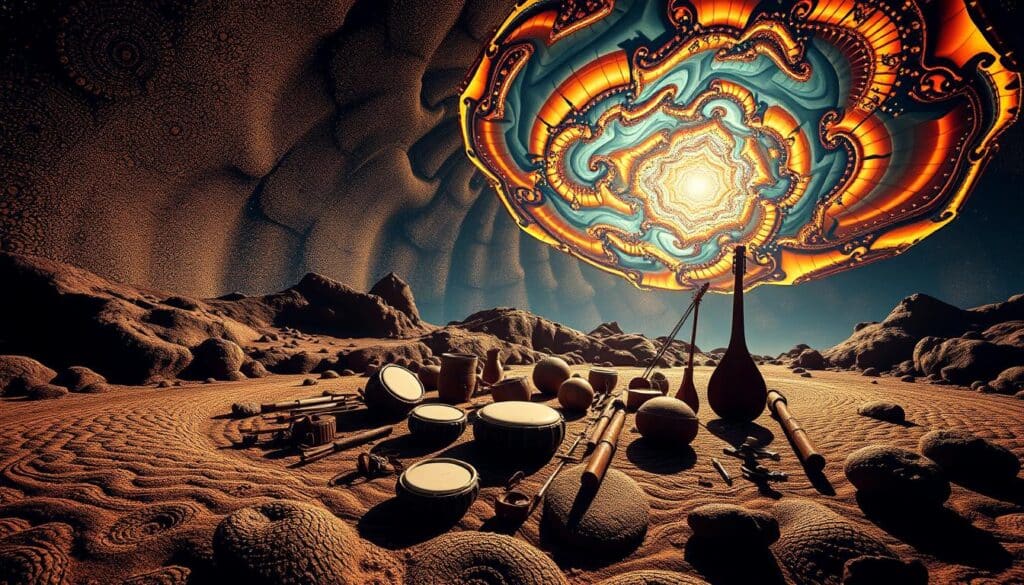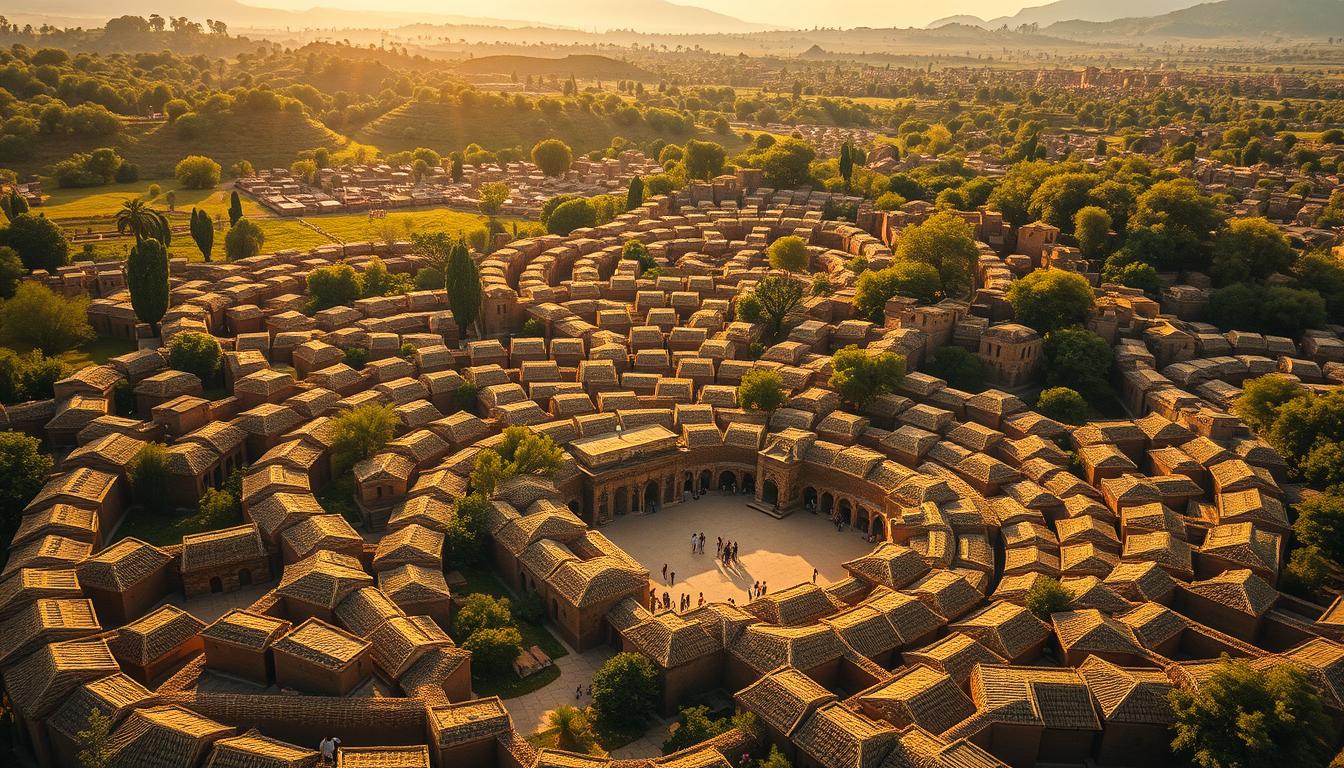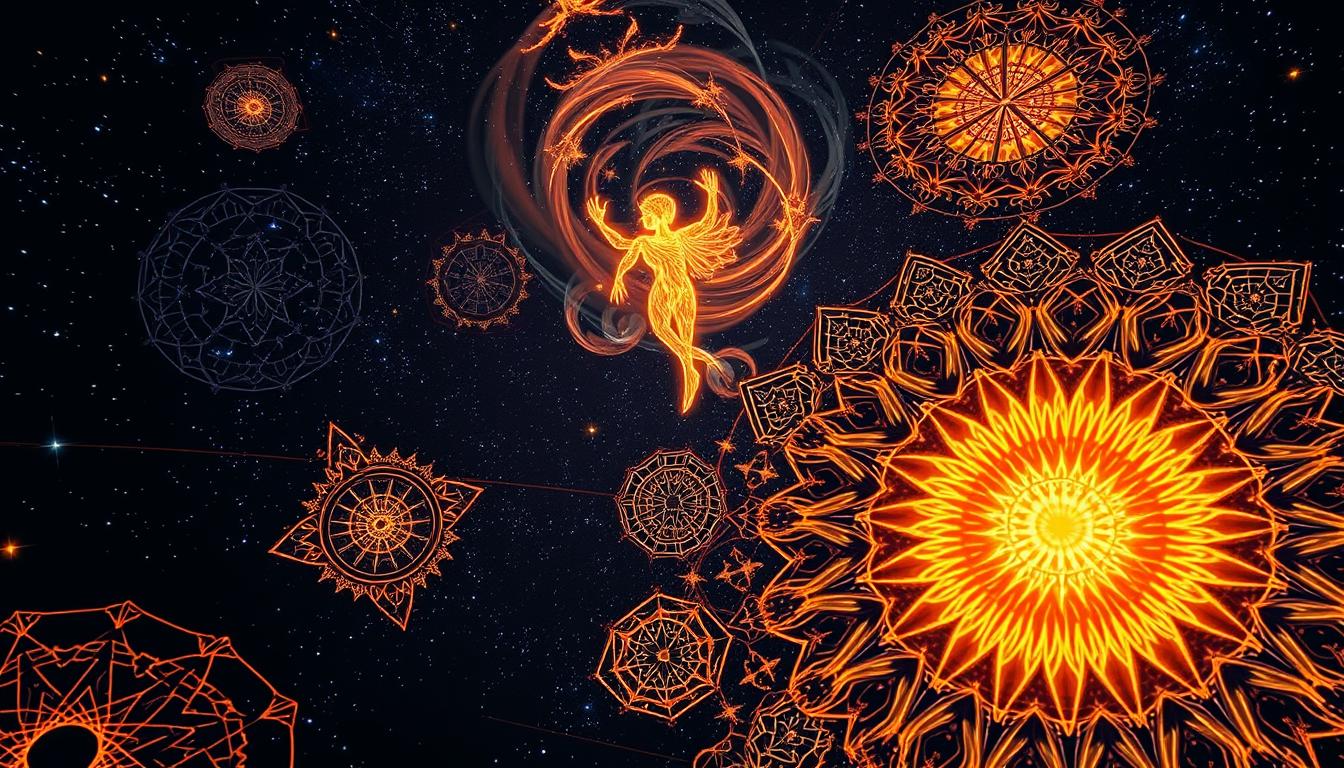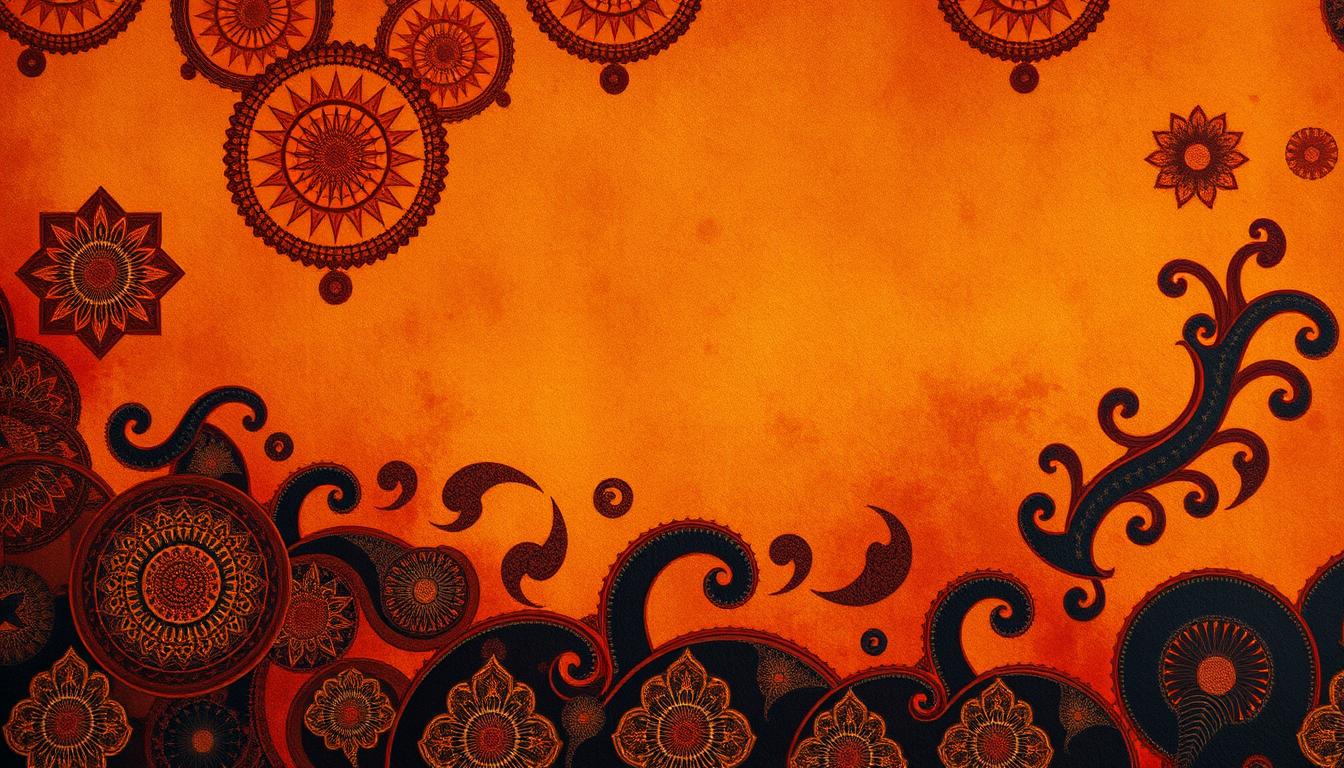In the music world, fractal harmonies show a deep link between native instruments and community rhythms. These instruments are made with years of skill. They are not just tools for sound but also symbols of cultural identity.
The music of different indigenous groups contain fractal math principles. This invites us to dive into their complex musical patterns. This is a start to understanding how native music mirrors a community’s soul. Every note played is tied to tradition, echoing a long history of creativity.
The Concept of Fractal Harmonies in Music
Fractal harmonies are a cool mix of math and music. They show how fractal principles appear in music creation. The idea of self-similarity is big here. It shows how some tunes repeat at different times.
This repetition makes the music feel familiar yet complex. It hits listeners in many ways. Musical structures often look like fractals. Composers use themes that echo earlier ones. This makes music complex but easy to get into. It shows the beauty of fractal designs.
Studies say these fractal-like patterns make music more interesting. They bring out the music’s deep layers and textures. As musicians dive into fractal harmonies, they bring fans into a deeper connection with the music.
The mix of math and art boosts creativity. It also makes the music scene richer. It makes people think differently about music and its structure. It opens the door to new ways of seeing music.

Understanding Indigenous Musical Instruments
Indigenous musical instruments are not just sound tools; they are treasures of rich traditions and histories. These instruments reflect the unique skills of various cultures. They are made from local materials, showing the artisans’ genius in combining function and beauty. The sounds of these instruments blend with the environment, tying each piece to its community.
Unique constructions and craftsmanship
Crafting indigenous musical instruments needs deep knowledge about materials and how sound is made. Artisans use things like wood, clay, and animal skins to make instruments such as drums, flutes, and stringed objects. These materials affect both how the instruments look and the sounds they make. Passed down skills make each instrument unique, blending function with tradition.
Cultural significance in various communities
Indigenous musical instruments mean a lot in different communities. They’re key in rituals, celebrations, and storytelling, linking past to present. The sound of these instruments creates a sense of belonging and identity. They strengthen social ties, whether played in big ceremonies or small gatherings. The music from these instruments shows the rich cultural links and the deep bond between sound and heritage.
Rhythmic Patterns in Indigenous Music
Indigenous music shows a vast array of rhythmic patterns that mirror the lives of different communities. These rhythms are central to their culture, especially in traditional events. We’ll explore these unique aspects and see how they differ from Western music’s rhythms.
Cyclic rhythms in traditional performances
Cyclic rhythms are key in indigenous music, often laying the groundwork for stories and group bonding. These rhythms welcome everyone to participate – by clapping, dancing, or singing. This builds a strong sense of togetherness through:
- Repetitive motifs that foster memorability.
- Variable tempos that enhance emotional expression.
- Interplay between instruments, complementing vocal elements.
Such rhythms create immersive events that deeply connect both players and listeners, going beyond just hearing the music.
Comparative analysis with Western music rhythms
Compared to this, Western music often sticks to strict patterns and different time signatures. While indigenous music is grounded in cyclic rhythms, Western music focuses on regular beats and harmony changes. This leads to very different music experiences. Differences noted are:
- Indigenous music values everyone joining in, while Western music often highlights solo performances.
- Western music tends to have a set structure, different from indigenous music’s fluid rhythms.
- Indigenous music encourages making it up as you go, unlike the fixed nature of Western tunes.
Looking at rhythm, both traditions have their unique ways, shaped by their cultures.
Fractal Harmonies: Indigenous Musical Instruments and Patterns
Studying fractal sound patterns in indigenous music helps us understand unique instrument traits. These complex patterns are like nature, showing music’s deep cultural roots. Different instruments blend together, enriching the audio scene with diverse cultural flavors.
Characteristics of fractal sound patterns
Fractal sounds have repeating structures and similarities at various levels. They’re found in the tunes and beats of traditional music, creating a sense of unity. Here are their main features:
- Layering of sounds, creating a rich texture.
- Repetitive motifs that evolve throughout a performance.
- Variation in dynamics and tempo that enhances expressiveness.
Examples from diverse indigenous cultures
Around the globe, indigenous people use music to showcase fractal sound beauty. For example:
- In Australian Aboriginal music, the didgeridoo brings out droning sounds and rhythmic patterns.
- Native American powwow drumming features complex layers and communal spirit.
- The Andean pan flutes offer cascading tunes reminiscent of their mountain homes.
Connections between Mathematics and Music
The relationship between math and music is deep and goes back centuries. People like Pythagoras showed us how math shapes music. He discovered that string lengths make sounds that agree with each other. This idea is behind the tuning systems we use today.
Fractals play a big part in linking math and music. They are complex patterns that repeat. These patterns are found in music, guiding composers and musicians. The repeating nature of fractals is like the repeating patterns in musical phrases. This repetition makes music more enjoyable for us.
Scales in music show math’s role clearly. They are made up of intervals defined by math. This allows musicians to explore different sounds. By blending math and music, they create diverse genres. This mix of art and math leads to unique musical pieces.
The Role of Ancestral Knowledge in Music Creation
Ancestral knowledge is key in creating music today. It binds new music to the deep roots of history. Musicians use old traditions to inspire their work. This mix makes a sound that respects culture but also speaks to today’s people.
Integration of historical practices in modern compositions
Today’s artists often use old ways in their music. They may:
- Play ancient instruments with deep meanings.
- Use rhythms that tell the story of their people.
- Sing in ways taught by their ancestors.
This method keeps history alive and adds depth to new music. It lets past and present converse in melody.
Influence of ancient music theories
Old music theories still shape music now. Influences are seen in:
- The scales and modes from old times.
- Melodies that reflect age-old wisdom.
- The way music is put together, showing beliefs about sound from the past.
Though music changes, ancient ideas still guide today’s sounds. They ensure the past enriches the new.
Exploring Generative Music and Fractals
Generative music combines art and technology, creating new sound experiences. It uses fractal algorithms for music composition. This lets artists make pieces that grow and change, mimicking nature’s complexity. It pushes musical creativity to new heights and blends traditional and modern sounds.
Incorporation of fractal algorithms in music composition
Fractal algorithms let composers use math in their art. They turn simple themes into complex pieces, enriching the sound texture. By changing the algorithms, composers can create unique and surprising pieces. This fresh approach to music has gained popularity for its innovation.
- Fractal algorithms help in creating self-similar patterns in sound.
- Generative music can implicitly reflect cultural influences and rhythms.
- Technology enhances accessibility for artists seeking to explore fractal-based composition.
Generative music often takes cues from indigenous themes. Artists use fractal algorithms to draw from the cyclical patterns of indigenous rhythms. This leads to new takes on traditional sounds. By mixing generative methods and cultural roots, the music becomes richer and celebrates diversity.
Health and Mental Benefits of Indigenous Music
Indigenous music is key in improving well-being, touching both health and mental state. It uses rich sounds and rhythms to help people emotionally and bring them together to heal.
Healing practices through sound and rhythm
Many cultures see music as a way to heal, using sounds and beats to fix physical and emotional problems. It’s about more than just having fun. It’s about getting better and feeling good.
Traditional beats from instruments can make people feel things deeply and connect them. Everyone feels part of a bigger group, helping each other heal.
Research findings on music and cognitive functions
Studies show that indigenous music helps with thinking and managing emotions. It can make memory better, help people focus, and deal with feelings. This music can make the brain work better.
Modern Innovations in Indigenous Music
The world of indigenous music is changing a lot because of new ideas. Today’s artists mix old styles with new ones. They create fresh music that many people enjoy and that also respects old traditions.
This mix of old and new helps different generations come together. Musicians use both traditional and modern sounds. This blend makes more people appreciate and understand where these traditions come from. It helps indigenous music find its place in the wide world of music.
Using technology to keep music alive is very important. Digital methods help save important cultural works. Artists can share their music online with fans all over the world. This helps keep indigenous music alive and relevant. It changes with the times but keeps its core values.
Conclusion
Exploring indigenous music and fractal harmonies shows us a world of culture and math. We’ve seen how native instruments and rhythms use fractal principles. These create patterns that sound beautiful and have deep cultural meaning. This mix of sound and structure shows the complexity of indigenous music.
The talk about rhythms and old knowledge shows that these traditions are still alive. They mix old ways with new ideas to create something unique. This lets indigenous music stay true to its roots and invites others to explore its heritage. Understanding this link between fractals and native music helps us appreciate different cultures and the universal music language.



